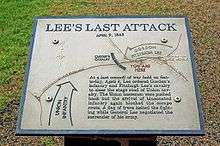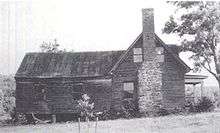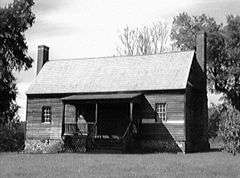Mariah Wright House
|
Mariah Wright House | |
|
Mariah Wright House | |
| Location | Appomattox County, Virginia |
|---|---|
| Nearest city | Appomattox, Virginia |
| Area | 1,800 acres (728 ha) |
| Built | 1823 |
| Architect | National Park Service |
| Visitation | 185,443[1] (2009) |
| Part of | Appomattox Court House National Historical Park (#66000827[2]) |
| Added to NRHP | October 15, 1966 |
The Mariah Wright house is a structure within the Appomattox Court House National Historical Park.[3] It was registered in the National Park Service's database of Official Structures on June 26, 1989.[4]
History
The Mariah Wright house was constructed in 1823 by Pryor Wright. The one-story post and beam building was inherited by his wife Mariah upon his death in 1851.[5]
It is important to the Appomattox Court House National Historical Park because of its association with the site where the surrender of the Confederate Army under Robert E. Lee to Union commander Ulysses S. Grant took place on April 9, 1865 with their major commanders. On that morning Brigadier General Joshua Chamberlain's Union infantry advancing through the village was halted on the outskirts of town. As his right flank reached the Mariah Wright house, a flag of truce came out from the Confederate lines. General George Armstrong Custer of Little Bighorn fame received the flag.[5]
Historical significance
The Mariah Wright House is historically important because it embodies the distinctive characteristics of a type, period, and method of construction in the nineteenth century in rural Virginia. The building and resources are typical of both a county government seat and of a farming community in Piedmont Virginia in the nineteenth century.[5]
Historical marker

A marker near titled "Lee's Last Attack" says:
At a last council of war held on Saturday, April 8, Lee ordered Gordon's infantry and Fitzhugh Lee's cavalry to clear the stage road of Union cavalry. The Union horsemen were pushed back but arrival of bluecoated infantry again blocked the escape route. A flag of truce halted the fighting while General Lee negotiated the surrender of his army.
Description and architecture

The single story Mariah Wright House is topped with a gable roof and attic. The structure is roughly forty feet deep by eighteen feet wide. The west side of the house has a full length front porch and a central east porch of sixteen and a half feet by seven and a half feet. Both porches are on stone piers with wood shingle shed roofs. The house siding is beaded pine weatherboard.[4]
The Mariah Wright House has centered external gable chimneys of filestone to the second floor level. It is stepped back in stone and continuing up as free-standing brick stacks with corbelled drips and accented whitewashed course just below the drip. The doors have six panels with raised centers on the west, east and south facades. The windows are a combination of 4/4 double hanging and 6/6 double hanging. There are two four-light casements flanking the chimney.[4]
The Mariah Wright House had an attached kitchen wing added around 1890. In 1965 the National Park Service restored the house, removing the kitchen wing and excavating a basement and full cement foundation. Extensive archeological investigations were conducted at this time and many artifacts were found.[6]
Footnotes
| Wikimedia Commons has media related to Appomattox Court House National Historical Park. |
- ↑ "NPS Annual Recreation Visits Report". National Park Service.
- ↑ National Park Service (2009-03-13). "National Register Information System". National Register of Historic Places. National Park Service.
- ↑ Marvel, A place called Appomattox, has an extensive bibliography (pp. 369–383) which lists manuscript collections, private papers and letters that were consulted, as well as, newspapers, government documents, and other published monographs that were used in his research of Appomattox.
- 1 2 3 Jon B. Montgomery; Reed Engle & Clifford Tobias (May 8, 1989). "National Register of Historic Places Registration: Appomattox Court House / Appomattox Court House National Historical Park (version from Virginia Department of Historic Resources, including maps)" (pdf). National Park Service. and Accompanying 12 photos, undated (version from Federal website) (32 KB) and one photo, undated, at Virginia DHR
- 1 2 3 "Mariah Wright House". Retrieved 2009-01-21.
- ↑ "Archeological Excavations at the Mariah Wright House South Chimney - Appomattox Court House, National Historical Park". Retrieved 2009-01-21.
Sources
- Bradford, Ned, Battles and Leaders of the Civil War, Plume, 1989
- Carroll, Orville W., Historic Structures Report Part III, Architectural Data Section on Mariah Wright House, Appomattox Court House National Historical Park. Ms. on file, National park Service, Chesapeake and Allegheny Systems Support Office, Philadelphia, Pennsylvania, 1965
- Catton, Bruce, A Stillness at Appomattox, Doubleday 1953, Library of Congress # 53-9982, ISBN 0-385-04451-8
- Catton, Bruce, This Hallowed Ground, Doubleday 1953, Library of Congress # 56-5960
- Davis, Burke, The Civil War: Strange & Fascinating Facts, Wings Books, 1960 & 1982, ISBN 0-517-37151-0
- Davis, Burke, To Appomattox - Nine April Days, 1865, Eastern Acorn Press, 1992, ISBN 0-915992-17-5
- Farrar, Stuart McDearmon, Historical Notes of Appomattox County, Virginia, self-published by Farrar, 1989, Original from the University of Virginia
- Featherston, Nathaniel Ragland, Appomattox County History and Genealogy, Genealogical Publishing Company, 1998, ISBN 0-8063-4760-0
- Fiero, Kathleen, Archeological Research Mariah Wright House Outbuildings, Historic Roads. National Park Service, Denver Service Center. Denver, Colorado, 1983
- Glassie, Henry H., Vernacular Architecture, Indiana University Press, 2000, ISBN 0-253-21395-9
- Gutek, Patricia, Plantations and Outdoor Museums in America's Historic South, University of South Carolina Press, 1996, ISBN 1-57003-071-5
- Hosmer, Charles Bridgham, Preservation Comes of Age: From Williamsburg to the National Trust, 1926-1949, Preservation Press, National Trust for Historic Preservation in the United States by the University Press of Virginia, 1981
- Howard, Blair et al., The Virginia Handbook, Hunter Publishing, Inc, 2005, ISBN 1-58843-512-1
- Kaiser, Harvey H., The National Park Architecture Sourcebook, Princeton Architectural Press, 2008, ISBN 1-56898-742-0
- Kennedy, Frances H., The Civil War Battlefield Guide, Houghton Mifflin Company, 1990, ISBN 0-395-52282-X
- Korn, Jerry et al., The Civil War, Pursuit to Appomattox, The Last Battles, Time-Life Books, 1987, ISBN 0-8094-4788-6
- Marvel, William, A Place Called Appomattox, UNC Press, 2000, ISBN 0-8078-2568-9
- Marvel, William, Lee's Last Retreat, UNC Press, 2006, ISBN 0-8078-5703-3
- McPherson, James M., Battle Cry of Freedom, Oxford University Press, 1988,
- National Park Service, Appomattox Court House: Appomattox Court House National Historical Park, Virginia, U.S. Dept. of the Interior, 2002, ISBN 0-912627-70-0
- Schlegel, Marvin W. and Carroll, Orville W., Historic Structures Report Part I, Administrative, Historical, and Architectural Data Mariah Wright House, Appomattox Court House National Historical Park, National Park Service, Chesapeake and Allegheny Systems Support Office, Philadelphia, Pennsylvania, 1959
- Tidwell, William A., April '65: Confederate Covert Action in the American Civil War, Kent State University Press, 1995, ISBN 0-87338-515-2
- Tyler, Lyon Gardiner, Tyler's Quarterly Historical and Genealogical Magazine, 1952
- Weigley, Russel F., A Great Civil War: A Military and Political History, 1861-1865, Indiana University Press, 2000, ISBN 0-253-33738-0

